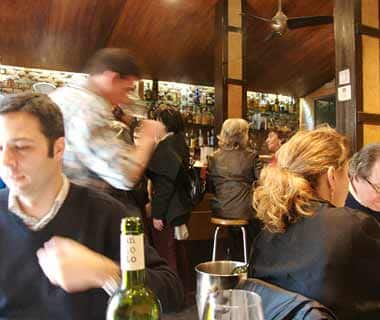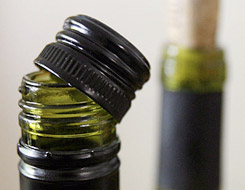Archive for the ‘wine classes’ Category
A Bit On Bordeaux..
Who says wine tastings are boring? On Tuesday, April 20th I attended a wine tasting sponsored by MacArthur’s Beverages at the Matisse Restaurant in Washington, D.C. with Jeffrey Davies, a well-known Bordeaux negociant, importer, and wine maker who actually is originally from the U.S. The event was to showcase the wines of Stephane Derenoncourt who unfortunately couldn’t make it because of the Icelandic volcano that erupted ash all over Europe and prevented him from flying into DC. This video is brief and covers some of the differences in how vines are chosen for the Right Bank vs. the Left Bank of Bordeaux. It was quite an educational experience for me as the tasting notes were extensive on the printed tasting sheet and included terms I was vaguely familiar with including microbullage and levurage
Twelve wines were tasted from a Gree Laroque 2005 priced at $20 to La Mondotte 2001 which will set you back $200 or so a bottle! There was also a special guest appearance by a winery that Monsieur Derenoncourt consults with in Virginia called Boxwood Winery – both the Boxwood Topiary Red 2007 and the Estate Red 2007 both at about $25/bottle showed very well against the French Bordeauxs – Rachel Martin, one of the owners spoke about making wine in Virginia at the event.

Oh, and for fun, here’s the video of Jeffrey on Wine Library TV:
The Last Corkscrew
I was on Lindsey Gustin’s cooking show on Channel 10 in Fairfax (public access) yesterday (http://geocities.com/chefsrecipes/index.html) when I noticed that out of the 9 bottles of wine I brought on the show, 3 had screwtops also known as Stelvin closures. Over at www.tastedc.com where I organize my many wine classes like the popular “Wine Basics 101” and also the exciting “Introduction to the Wines of Italy: Wines of Sicily and the South” on Thursday, December 4th, I often notice that the wines being served have changed from cork to screwtop. For awhile, this was mostly Sauvignon Blancs from New Zealand, but I’m even seeing German Rieslings and the Shiraz from Australia had Stelvins too!
I’ve read alot about the cork vs. screwtop controversy (you can add in plastic corks too) and George Taber wrote a whole book on it “To Cork or Not to Cork” http://www.amazon.com/Cork-Not-Tradition-Romance-Science/dp/0743299345 which really covered the topic in depth. In a nutshell, cork comes from the bark of a tree primarily grown in Portugal and Spain. It’s a renewable resource, every 10 years bark is taken from the same trees and they continue to live and give cork bark for maybe around 200 years. The problem is with the world demand for cork for wine, the cork industry has a tough time “curing” the cork so that it is free of offending organisms. Something like 3% to 8% of all wines sold have a TCA problem also known as 2,4,6 trichlooanisole or cork taint. The offensive odor can be noticed in very small amounts in solution, it has a very mildewy wet cardboard aroma.
So if you manufactured a product and sold it to the public, but 1 out of 20 was defective, would you consider this an acceptable fault rate? Probably not, but it is a reality. And the solution seems to be just a better closure – and screwtops have been used successfully in many consumer applications and have worked very well. A few other points to mention:
- corks break and seep air; screwtops really do not,
- if you store wines for more than a few months, you need to lay them down horizontally if they have a cork because if the cork grows dry, it will seep in air; Screwtop wines are perfectly fine standing them up in storage,
- corks are hard to get out and need some type of corkscrew; Screwtops you simply twist,
- corks can be hard to get back into the bottle or you need to find another closure device; Screwtops screw right back on,
- corks rely on agricultural resources; screwtops are an industrial product.
The last point has caused some controversy–The World Wildlife Fund put together a PR release to protect certain animals that might lose their cork tree forest if demand for cork significantly changes because of new technology..but need I say more? Kind of ridiculous on so many fronts–sure I want to protect the natural habitat, but the cork industry is just that, a business, and there are other ways to get businesses and people to be socially responsible–don’t force them to accept a 1 in 20 defective rate to save birds!!
Whooops, almost forgot, I had lunch today at Agraria in Georgetown and purchased a relatively expensive Pinot Noir from Oregon (Maysara) and yes, you guessed it, it had a screwtop!
I’ll cover more on cork and screwtops in the near future, and I will also cover the plastic closure – seems many TasteDC’s wine class attendees like the idea of some kind of cork being presented when they sit down to eat in a restaurant, I guess the breaking of the metal and offering of a screwtop just doesn’t cut it for them; but what will they do when box wines become better and more popular?
Charlie “I Drink On the Job” Adler
Wine Basics – Getting Started Right
Every year around 1,000 people in the DC area attend TasteDC’s Wine Basics 101 in order to get a solid understanding of wine. Over 11 years, 15,000 people have attended and I like to think that this has had a significant effect on Washington, D.C. both as a place to find many excellent wine stores and restaurants serving wine as well as a very wine educated public. Originally, this class was taught by local wine professionals, but I teach it now because it is so important for people to get the basic message/premise of drinking wine at TasteDC – it’s all about pleasure and fun, snobbery can stay at home!
I’ve found after teaching this class for the last 5 years that many people are confused about wine, in particular:
- Most people think that quality and price are directly related, but this isn’t true,
- Try to “describe” wine with accuracy when this is relatively unimportant and misleading at best,
- Spend too much on glassware and other accessories that don’t improve much the wine drinking experience,
This Thursday, November 13th is the next Wine Basics 101 class and my chance to cover the hot topics and important facts on wine. If you know very little about wine or are looking for a refresher class, give us a try at www.tastedc.com.
Charlie “I Drink On the Job” Adler








